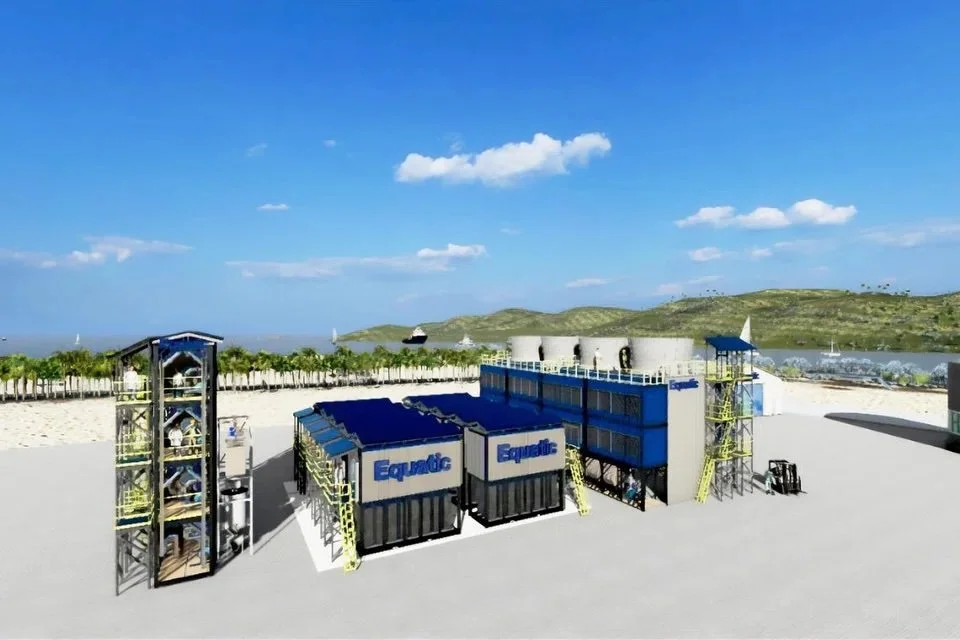World’s largest facility to remove ocean CO2 to open in Singapore: How does it work?
The Equatic-1 demonstration plant in Tuas is a collaboration between national water agency PUB and American start-up Equatic. PHOTO: EQUATIC
The Straits Times | Sept 1, 2025
By Chin Hui ShanSINGAPORE - The largest facility in the world that can help to remove planet-warming carbon dioxide (CO2) from the ocean, located in Singapore in Tuas, is expected to begin operations in the first quarter of 2026.
It uses technology to change the chemistry of seawater and remove dissolved CO2 so that the water can absorb more CO2 when released back into the ocean, The Straits Times had earlier reported.
The seawater is discharged back into the ocean only after it is processed to preserve the ocean’s chemistry.
Efforts that manipulate natural processes to tackle climate change are known as geoengineering.
Tuas’ Equatic-1 demonstration plant is a collaboration between Singapore’s national water agency PUB and American start-up Equatic, which developed the technology.
ST finds out more about this nascent technology, as well as its benefits and challenges.
What are the different approaches to mCDR?
CSIRO’s Dr Lenton said there are mainly two approaches to mCDR – chemical and biological.
The Equatic-1 facility will use the chemical method, he added.
An electrical current is passed through the seawater pumped into the plant from adjacent desalination plants.
This leads to a series of chemical reactions that split the seawater into hydrogen and oxygen. The dissolved CO2 is combined with minerals in seawater like calcium and magnesium to produce solid limestone – essentially trapping the CO2 for at least 10,000 years.
The process mimics the natural formation of seashells. The solid calcium and magnesium-based materials can either be stored on the ocean floor, or potentially be used as construction materials.
Biological methods include farming seaweed or restoring coastal ecosystems like mangroves.
Seaweed absorbs CO2 through photosynthesis. The seaweed may then be harvested or sunk to deep waters to store the carbon for a long time.
Blue carbon ecosystems such as mangroves, wetlands and seagrass, are natural carbon sinks. Restoring these ecosystems would enable them to take in large amounts of carbon.
Chemical approaches are currently the most technologically advanced and scalable techniques based on field trials to date, according to a blue paper commissioned by the High Level Panel for a Sustainable Ocean Economy (Ocean Panel) launched in June.
The Ocean Panel is an initiative of world leaders working together towards a sustainable ocean economy.
How does mCDR affect the marine environment?
The answer to this is not immediately clear, but scientists have warned that the environmental impact of mCDR technology warrants further study.
Dr Xu Haoxin, chief consultant of carbon capture at consultancy firm Ramboll, said that the long-term ecological effects of the removal processes on the marine ecosystems are not yet fully understood.
While the concept holds promise, this is a fairly new research field and much more work needs to be done, she added.
The Ocean Panel blue paper also noted that given the interconnectivity and interdependency of different oceanic environments, any intervention is likely to have environmental impacts.
For example, pH disruption to processes like photosynthesis can affect ecosystem services such as biological carbon sequestration (carbon dioxide removal by natural ecosystems), food production and water quality. pH is a measure of acidity and alkalinity.
Marine biogeochemist Patrick Martin from Nanyang Technological University’s Asian School of the Environment previously told ST that Equatic’s technology, if deployed at a large-enough scale, could represent a “major manipulation” of the ocean’s chemistry.
“When you start doing manipulations in the ocean, you change the ocean’s chemistry. Some species might be fine with that, other species might be harmed by it,” Associate Professor Martin said.
Some methods may change the concentrations and ratios of important dissolved elements such as calcium and magnesium, which are essential for marine species like corals to form shells and skeletons, he said. Other methods may increase the concentrations of harmful trace metals in seawater, which might be toxic for many marine species, he added.
Equatic told ST that its technology was “designed with the health of the ocean in mind”.
“Potential impacts on the marine environment are important considerations and our process directly addresses them through built-in safeguards,” it said.
“Years of ongoing research underpin our approach and we continue to run extensive laboratory-based, and full-scale simulation studies to evaluate environmental effects,” said Equatic.
The company added that ongoing studies have indicated no harm to the marine environment when processes are kept within the ocean’s natural limits.
Read it on The Straits Times


